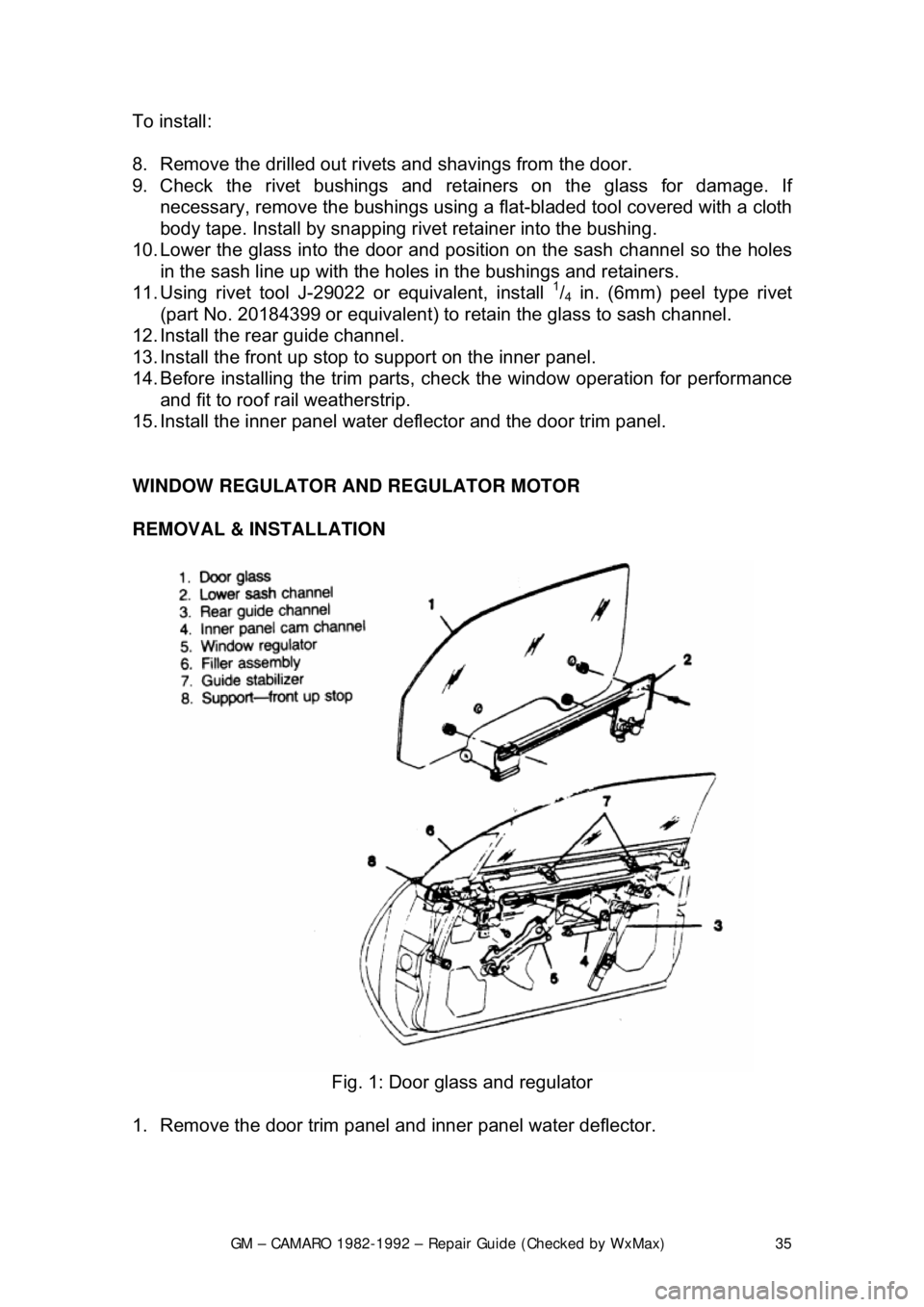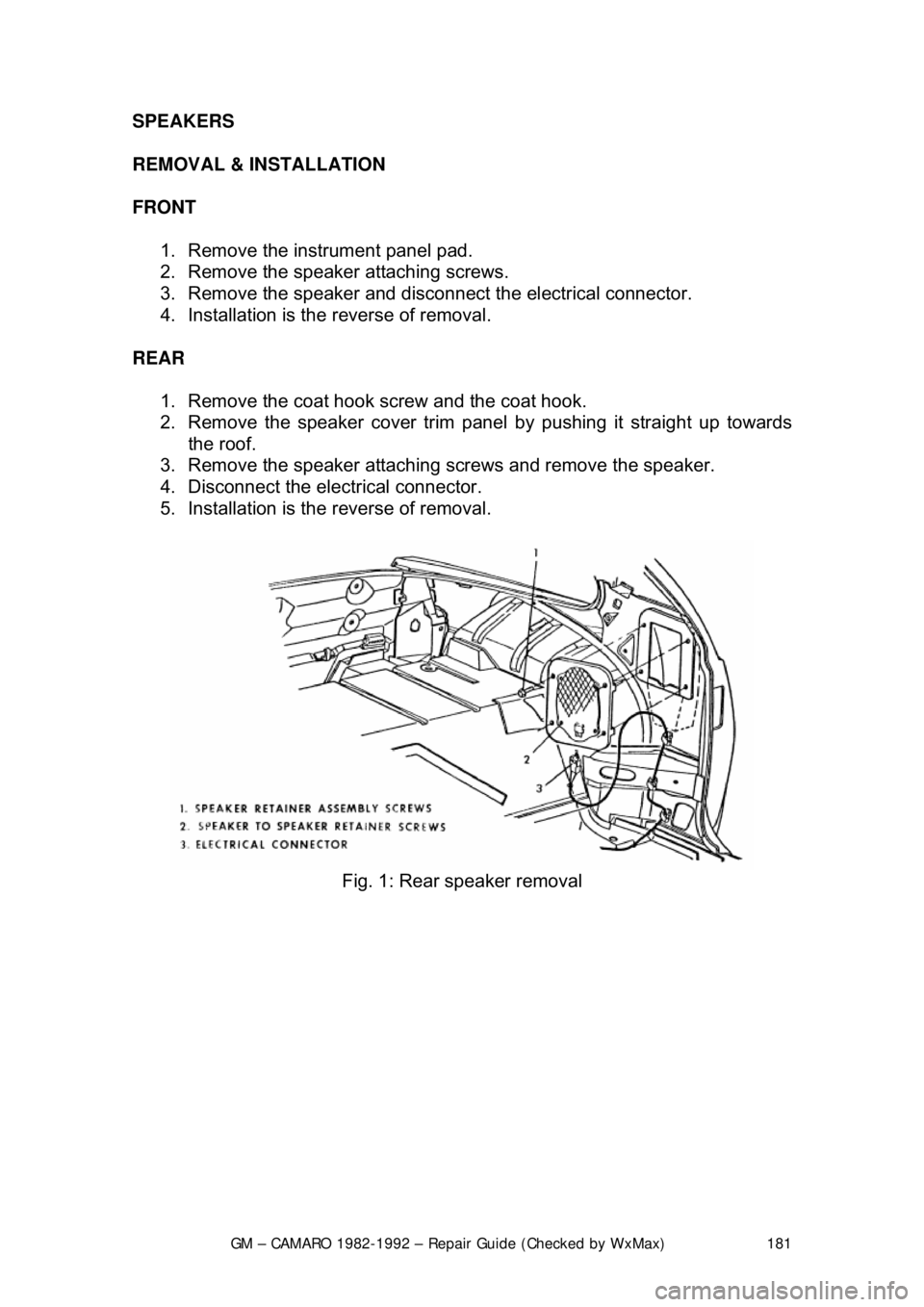1982 CHEVROLET CAMARO roof
[x] Cancel search: roofPage 35 of 875

GM – CAMARO 1982-1992 – Repair Guide (Checked by WxMax) 35
To install:
8. Remove the drilled out rivets and shavings from the door.
9. Check the rivet bushings and re
tainers on the glass for damage. If
necessary, remove the bushings using a flat-bladed tool covered with a cloth
body tape. Install by snapping rivet retainer into the bushing.
10. Lower the glass into the door and position on the sash channel so the holes
in the sash line up with the holes in the bushings and retainers.
11. Using rivet tool J-29022 or equivalent, install
1/4 in. (6mm) peel type rivet
(part No. 20184399 or equivalent) to re tain the glass to sash channel.
12. Install the rear guide channel.
13. Install the front up stop to support on the inner panel.
14. Before installing the trim parts, c heck the window operation for performance
and fit to roof rail weatherstrip.
15. Install the inner panel water deflector and the door trim panel.
WINDOW REGULATOR AND REGULATOR MOTOR
REMOVAL & INSTALLATION
Fig. 1: Door glass and regulator
1. Remove the door trim panel an d inner panel water deflector.
Page 134 of 875

GM – CAMARO 1982-1992 – Repair Guide (Checked by WxMax) 134
CONNECTORS
Three types of connectors
are commonly used in automotive applications -
weatherproof, molded and hard shell.
Fig. 4: Hard shell (left) and weather proof (right) connectors have replaceable
terminals
• Weatherproof - these connectors ar e most commonly used where the
connector is exposed to the element s. Terminals are protected against
moisture and dirt by sealing rings wh ich provide a weathertight seal. All
repairs require the use of a specia l terminal and the tool required to
service it. Unlike standard blade ty pe terminals, these weatherproof
terminals cannot be straightened once they are bent. Make certain that
the connectors are properly seated and all of the sealing rings are in
place when connecting leads.
• Molded - these connectors require complete replacement of the
connector if found to be defective. This means splicing a new connector
assembly into the harness. All sp lices should be soldered to insure
proper contact. Use care when probi ng the connections or replacing
terminals in them, as it is possibl e to create a short circuit between
opposite terminals. If this happens to the wrong terminal pair, it is
possible to damage certain com ponents. Always use jumper wires
between connectors for circuit c hecking and NEVER probe through
weatherproof seals.
• Hard Shell - unlike molded connectors, the terminal contacts in hard-shell
connectors can be replaced. Replacement usually involves the use of a
special terminal removal tool that depresses the locking tangs (barbs)\
on
the connector terminal and allows the connector to be removed from the
rear of the shell. The connector she ll should be replaced if it shows any
evidence of burning, melting, cracks, or breaks. Replace individual
terminals that are burnt, corroded, distorted or loose.
Page 135 of 875

GM – CAMARO 1982-1992 – Repair Guide (Checked by WxMax) 135
Fig. 5: Weatherproof connectors ar e most commonly used in the engine
compartment or where the connecto r is exposed to the elements
TEST EQUIPMENT
Pinpointing the exact cause of trouble in an electrical circuit is most times
accomplished by the use of special te st equipment. The following describes
different types of commonly used test eq uipment and briefly explains how to
use them in diagnosis. In addition to t he information covered below, the tool
manufacturer's instructions booklet (pro vided with the tester) should be read
and clearly understood before atte mpting any test procedures.
JUMPER WIRES
CAUTION - Never use jumper wires made from a thinner gauge wire than the
circuit being tested. If the jumper wire is of too small a gauge, it may overheat
and possibly melt. Never use jumpers to bypass high resistance loads in a
circuit. Bypassing resistances, in effect, cr eates a short circuit. This may, in
turn, cause damage and fire. Jumper wi res should only be used to bypass
lengths of wire or to simulate switches.
Jumper wires are simple, yet extremel y valuable, pieces of test equipment.
They are basically test wir es which are used to bypass sections of a circuit.
Although jumper wires can be purchased, they are usually fabricated from
lengths of standard automot ive wire and whatever type of connector (alligator
clip, spade connector or pin connector) that is required for the particular
application being tested. In cramped, hard- to-reach areas, it is advisable to
have insulated boots over the jumper wire terminals in order to prevent
Page 144 of 875

GM – CAMARO 1982-1992 – Repair Guide (Checked by WxMax) 144
1. Isolate the circuit from
the vehicle's power source.
2. Ensure that the ignition key is OFF when disconnecting any components
or the battery.
3. Where necessary, also isolate at least one side of the circuit to be
checked, in order to avoid reading parallel resistances. Parallel circuit
resistances will always give a lower reading than the actual resistance of
either of the branches.
4. Connect the meter leads to both sides of the circuit (wire or component)
and read the actual measured ohms on the meter scale. Make sure the
selector switch is set to the proper ohm scale for the circuit being tested,
to avoid misreading the oh mmeter test value.
WIRE AND CONNECTOR REPAIR
Almost anyone can replace damaged wires, as long as the proper tools and
parts are available. Wire and terminals ar e available to fit almost any need.
Even the specialized weatherproof, mol ded and hard shell connectors are now
available from aftermarket suppliers.
Be sure the ends of all the wires are fitted with t he proper terminal hardware
and connectors. Wrapping a wire around a stud is never a permanent solution
and will only cause trouble later. Repl ace wires one at a time to avoid
confusion. Always route wires exac tly the same as the factory.
If connector repair is necessary, only atte mpt it if you have the proper tools.
Weatherproof and hard shell con nectors require special tools to release the pins
inside the connector. Attempting to r epair these connectors with conventional
hand tools will damage them.
BATTERY CABLES
DISCONNECTING THE CABLES
When working on any electrical component on the vehicle, it is always a good
idea to disconnect the negative (-) battery cable. This will prevent potential
damage to many sensitive electrical co mponents such as the Engine Control
Module (ECM), radio, alternator, etc.
Any time you disengage the battery cables, it is recommended that you
disconnect the negative (&mdash) battery cable first. This will prevent your
accidentally grounding the positive (+) term inal to the body of the vehicle when
disconnecting it, thereby prevent ing damage to the above mentioned
components.
Before you disconnect the cable(s), first turn the ignition to the OFF position.
This will prevent a draw on the battery which could cause arcing (electricity
trying to ground itself to the body of a vehi cle, just like a spark plug jumping the
gap) and, of course, damaging some com ponents such as the alternator diodes.
Page 181 of 875

GM – CAMARO 1982-1992 – Repair Guide (Checked by WxMax) 181
SPEAKERS
REMOVAL & INSTALLATION
FRONT
1. Remove the instrument panel pad.
2. Remove the speaker attaching screws.
3. Remove the speaker and disconnect the electrical connector.
4. Installation is the reverse of removal.
REAR 1. Remove the coat hook screw and the coat hook.
2. Remove the speaker cover trim panel by pushing it straight up towards
the roof.
3. Remove the speaker attaching screws and remove the speaker.
4. Disconnect the electrical connector.
5. Installation is the reverse of removal.
Fig. 1: Rear speaker removal
Page 780 of 875

GM – CAMARO 1982-1992 – Repair Guide (Checked by WxMax) 780
If the drain plug is equipped with a re
movable washer or gasket, check its
condition and replace, if necessary , to provide a leakproof seal.
5. Quickly withdraw the plug and move your hands out of the way. Allow the
oil to drain completely into the pan, then install and carefully tighten the
drain plug. Be careful not to overtighten the drain plug, otherwise you'\
ll
be buying a new pan or a replacem ent plug for stripped threads.
Fig. 5: Use a wrench or a socket to l oosen the oil pan drain plug, but use care,
the engine oil may be very hot
Although some manufacturers recommend c hanging the oil filter every other oil
change, we recommend the filter be chan ged each time you change your oil.
The old filter will contain up to a quart of dirty oil, which will contaminate the
clean oil. Also, the benefit of clean oil is quickly lost if the old filter is clogged.
The added protection for your engine far outweighs the few dollars saved by
using an old filter.
6. Move the drain pan under the oil filter. Use a strap-type or cap-type filter
wrench to loosen and remove the oil f ilter from the engine block. Keep in
mind that it's holding about one quart of hot, dirty oil.
7. Empty the old f ilter into the drain pan and proper ly dispose of the filter.
8. Using a clean rag, wipe off the filt er adapter on the engine block. Be sure
that the rag doesn't leave any lint which could clog an oil passage.
9. Coat the rubber gasket on the filter with fresh oil, then spin it onto the
engine by hand; when the gasket touches the adapter surface, give it
another
1/3-1/2 turn, (but no more, or you'll squash the gasket and it will
leak).